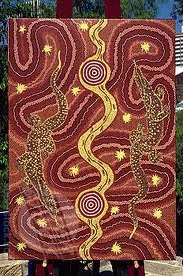Dream interpretation among indigenous peoples
Dream interpretation has a long history, both honorable and dishonorable, both written and otherwise. Almost every so-called primitive people engages in some form of it, the most prominent examples being possibly the Senoi in southeast Asia (though this is contested) and the Australian aboriginals who live in intimate contact with what they refer to as the dreamtime. Further examples are provided by the Achuar, an Ecuadorean Amazon tribe and the Lacandon, the descendants of the Maya in Mexico.
According to Kilton Stewart (Stewart, 1969, pp. 301 - 304), the Senoi instruct their children to confront any nightmare creature and defeat it, not letting it go until it provided some gift, such as a dance, song, poem or story. Whatever was given the child by its dream-monster was then shared with the rest of the tribe and sometimes was even incorporated into their tribal life (Kaplan-Williams, 1980, pp. 161 - 170).
The aboriginals in Australia live in intimate contact with the places they inhabit and move through and these are then incorporated into their mythology and lore. Their songs and tales serve as a sort of map, providing orientation: if they know the song of a place, they can find their way about. They live in cyclical time, in keeping with the seasons that endlessly repeat themselves, and thus have no concept of linear time or history in our sense in which events follow one another in a serial, never-repeating, never-ending progression. What they meet in their dreams is as real for them as anything else they have to deal with (Chatwin, 1987; Morgan, 1991).
This attitude towards dream-reality is also found among the Achuar Indians who live on the Amazon in Ecuador. Anthropologist Marilyn Schlitz has found that dream sharing is central in their culture. She wrote, "For the Achuar, like other indigenous peoples of the Amazon, the normal waking state is an illusion; the true nature of reality is perceived and manipulated within dreams and hallucinogenic visions. Thus, these forest dwellers find access to forces that are not revealed in everyday 'illusory' awareness. They believe that something akin to a soul-body leaves their physical body to travel within a parallel world. The dream journey yields precognitive insights into the future - suggesting strategies for the day's activities" (Schlitz, 1998).
A system of dream interpretation that seems quite modern was found by the anthropologist R. D. Bruce in his work among the Lacandon Indians in southern Mexico and Guatemala. He was initially told by one of these Mayan descendants a very (over-)simplified version of their approach to dreams which is as follows: "A dream is a kind of lie. It tells the future, but it doesn't always tell it at face value. Proportions and qualities are seen in reverse: much corn foretells its scarcity, and what one dreams is great will be small. Also, people appear as animals in dreams, and vice versa" (Bruce, 1975, p. 19). Those familiar with Jung's theory of dream compensation will recognize it here, I am sure.
Next section List of sections List of chapters

